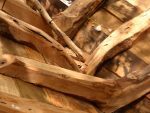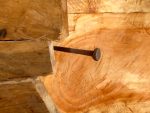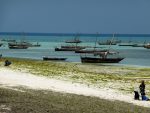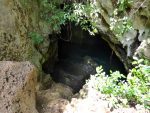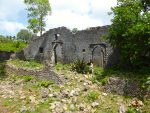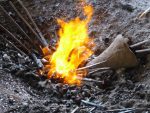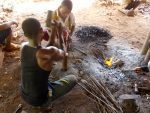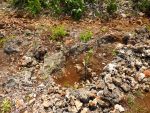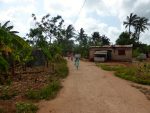It is hot cycling north Zanzibar
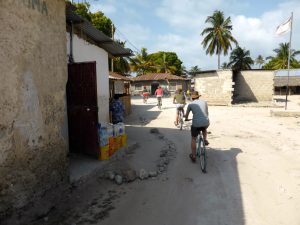
Yes, as you ask, riding bikes through the Northern tip of Zanzibar is hot and sweaty work; but it’s mostly fun too.
We set out on bikes that had seen better days but were still a cut above those being used by the locals. Ours had gears, seats, and the occasional brake. It was already hot as we started out but after only a short while we got off the main road and were riding on dirt and in the shade of trees into a small village. As we rode into the village we gathered a comet-tail of young kids smiling and shouting. We were clearly the novelty act for the day. The little kids are very cute; somewhat strangely, the girls all seem to be wearing disheveled party dresses.
The kids are on school holiday at the moment and haven’t started learning English at school really. In the township with the hotels there is so much English about that they all pick some up, but out in the villages that’s not the case. So there was a lot of smiling and shouting ‘jambo’ for hello.
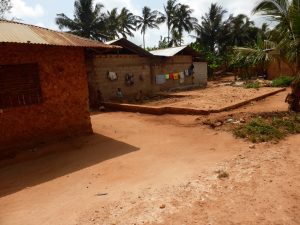
We got off our bikes to walk through a blasted landscape of limestone rocks that looked like you’d imagine the beginning of terraforming on Mars. It took a while to realise that this was in fact a communal field. The villagers subsist on fishing and a little farming. The farming involves scraping a hole, seemingly at random, to plant an individual tuber in and then surrounding the roots with rocks to provide some shade. Then each day the women walk in a jerry-can of water and put a cup onto each of the plants. It’s backbreaking, manual labour that’s barely rewarding.
So you can imagine that having a tourist attraction was seen as a boon to the village. The attraction is two caves that were ‘discovered’ only four years ago. The locals sort of knew they were there but absolutely never ventured into them until one day a young man tried to rescue his dog which had fallen into one of the caves. The young man was unusual both because he was prepared to enter the cave and because he cared for a dog which our guide explained made him very unusual in the Muslim country. Anyway, he realised that the limestone caves had stalagmites and stalactites and a little tourist industry was born.
Now these are not huge towering caves of coloured crystals. They are small, strangely hot, and all white. But there are some lovely limestone curtains and stalactites; and the whole operation is endearing, especially when you realise how impoverished the locals are.
We rode on through yet more hordes of children shouting ‘jambo’ and waving wildly. With the occasional one who was obviously paying more attention at school also adding in a loud ‘bye-bye’.
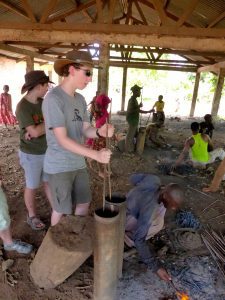
Our next stop was a blacksmithing village. Under an open-sided rooftop sat several groups of men working around small fires. The smiths we saw were making nails for boat building. The fascinating thing was that everything was recycled. A lot of their tools were car parts and all the metal they were working was re-bar. There was something quite strange to contemplate in the idea that they were re-working discarded re-bar into hand-made nails that would be used in making wooden dhows.
On again with the day heating up and the sweat pouring off of us. Now at this point I was going to make an acerbic comment about the fact that it was terribly noticeable that the women all seemed to be working away while the men pursued a fine line in shade-sitting. That was until I realised that from the outside looking in, that’s pretty much my life. So no acerbic comment. But, just saying.
If we were finding it hot, and we were, I can only imagine how the Portugese in the 16th century felt in the European clothes and without the thought of a pool a cold beer and an air-conditioned room to tempt them onwards. We got some insight when we stopped at the remains of the Portugese trading settlement. It’s amazingly intact, but then it was built with deep thick walls complete with loopholes for guns and huge surrounding walls to keep the natives at bay. The rooms were all internal and there were no windows which presumably helped with the heat. And there is the pool.
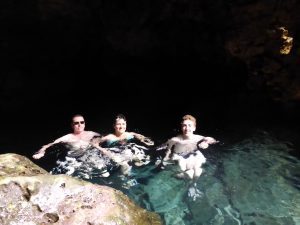
The pool is a natural cave that is fed by both salt and fresh water. You clamber down about 20 meters to water so utterly clear that until something splashes it you have absolutely no way to know it is there. I thought I was putting my foot onto the next foothold down and was completely taken by surprise when it hit water. Being so deeply in the shade, the water was lovely and cool and refreshing.
If we could have ended out tour there after a swim and a picnic of fresh fruit that would probably have been a good thing. Unfortunately we then had to ride about 12km back to our starting point. Suffice it to say that, by the time we got back, bits were sore, everything was sweat-soaked, and we were not at our best.
We did summon the energy to explore the local shipyard where they build dhows entirely by hand and, apart from those nails we saw being made earlier, entirely of wood. The Arabs taught them how to do this centuries ago and it has been passed down in families ever since. Like many of these things the skills are fading as the younger generation lacks the will and the patience to shape wood with a hand axe for hours and days and weeks on end.
Anyway for us it was then swimming pool. Milkshakes. Beers. Relief.
